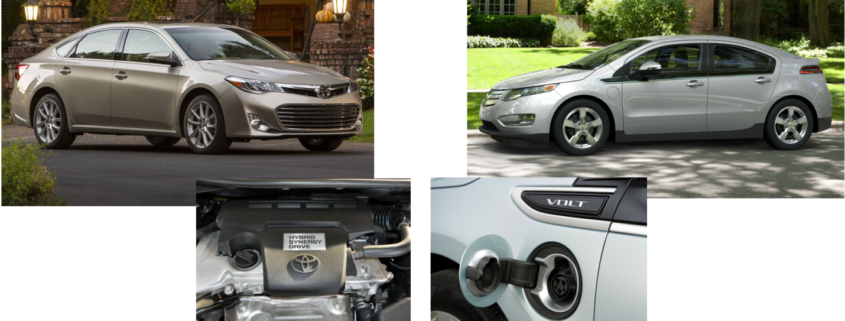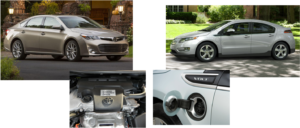Electrification Update
Back to the topic of electrification and hybrid technology: it’s a big deal here at PG. Big enough that we plan to display our Hybrid technology at the upcoming Green Industry and Equipment Expo (GIE) in Louisville (October 19-21).
And, as I mentioned in my last entry, at PG we “live the promise” of electrification in our personal mobility choices, too. I drive a Toyota Avalon Hybrid; my Sales boss has gone a step further by choosing a plug-in: a Chevy Volt.
The PG Fleet: Avalon Hybrid and Volt Plug-In Hybrid
Beside the fact that we love great cars that sip fuel while delivering smooth, quiet and responsive rides, we also think it’s important to have daily, personal experience and understanding of the technologies we offer to our customers.
The Key Electrification Principle
The Avalon and the Volt above apply a simple principle: optimize the combination of a smaller, lower-output engine and electrical energy storage (a battery) to perform the desired mission while burning the least amount of fuel.
The Avalon uses a small battery for startup, very low speed driving and acceleration assist, with the engine operating most of the time. It gives excellent all-around performance on much less fuel. The Volt has a bigger battery that fully powers the car for about 40 miles, but operates much like the Avalon when the battery is near depletion. The result is silent, emission-free urban/suburban driving, with fuel burned only when needed for longer drives.
The design teams adopted different strategies, to be sure. But both companies optimized a battery/engine combination for the mission, and exploited advantages of electric accessories (A/C, power steering, etc.) to use energy more efficiently.
And we’re doing the same here at PG.
Here’s what it means to you
Electrification promises new advances for cleaner, more efficient engine-driven equipment, and not just for cars. PG offers robust , affordable, safe electrification solutions to landscaping and industrial applications… solutions that result in:
- smaller engines operated more efficiently,
- flexibility in vehicle configuration and manufacture, and
- greater productivity throughout the entire value chain, from factory to field.
Would you like to…
– avoid the expensive and complex Tier-IV emission solutions for engines in the 25-30hp range, but still maintain overall performance?
– evict hydraulic fluids from your factory, customer working environment, and service area?
– offer your customers the option for silent operation during load/unload and transport?
Then give us a call, drop an e-mail, or best of all make a plan to see us at the GIE (booth 10083) to discover the possibilities of electrification.
Meanwhile watch this space!
‘Til next week,
Dave





